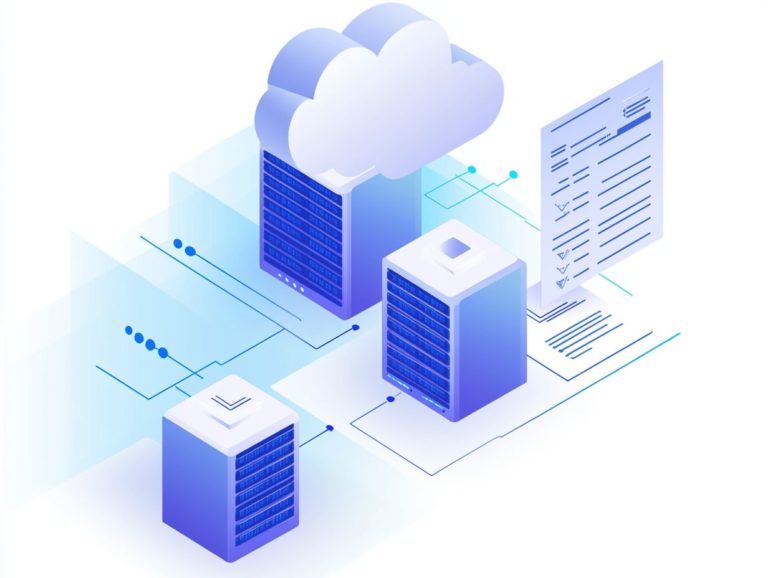Common Mistakes in Cloud Migration Projects
In today s digital world, cloud migration is a key strategy for businesses. It aims to boost efficiency, scalability, and performance.
However, moving to the cloud isn t without its challenges. Many organizations stumble upon common pitfalls that can impede their success.
This article explores the benefits of cloud migration. It also highlights common mistakes, such as poor planning and cost underestimation, and offers actionable steps for a smooth transition.
Are you ready to unlock the full potential of cloud migration? Discover how to avoid pitfalls and maximize your journey!
Contents
- Key Takeaways:
- Benefits of Cloud Migration
- Common Mistakes in Cloud Migration Projects
- How to Avoid Mistakes in Cloud Migration
- Frequently Asked Questions
- What are some common mistakes made in cloud migration projects?
- Why is planning crucial in cloud migration projects?
- What happens when costs and resources are underestimated?
- How does neglecting security and compliance hurt your cloud migration?
- Why is training and communication key in cloud migration?
- How do you ensure a backup plan is in place during migration?
Key Takeaways:

Proper planning is crucial to the success of a cloud migration project. Failure to plan can lead to delays, unexpected costs, and potential security risks.
Underestimating the costs of cloud migration can result in budget overruns and hinder the ROI of the project. To avoid this, understanding the top challenges in cloud migration and solutions is crucial. It is also important to consider all factors, including training and security measures.
Insufficient training and knowledge can hinder the adoption and success of a cloud migration. Invest in training and educating your team to ensure a smooth transition and maximize the benefits of the cloud.
What is Cloud Migration?
Cloud migration is the process of moving data, applications, and various business elements from your on-premises infrastructure to cloud services, or even from one cloud environment to another. This isn’t just a simple switch; it often involves complex strategies designed to minimize disruption to your operations and maintain the integrity of your data throughout the transition.
Different cloud providers offer a range of solutions that can significantly elevate your organizational goals through improved efficiency and scalability.
In this context, data migration means moving your information from local storage to the cloud. It involves transferring all types of data both structured and unstructured from your local storage systems to cloud platforms. Cloud transition covers everything from meticulous planning and execution to fine-tuning post-migration.
As you navigate this journey, you’ll need to consider various types of cloud services, such as:
- Software as a Service (SaaS)
- Infrastructure as a Service (IaaS)
- Platform as a Service (PaaS)
Each of these options presents unique advantages tailored to specific business needs. Aligning your cloud migration with a well-defined IT strategy is essential; it ensures that your chosen path not only supports your immediate goals but also addresses long-term objectives, including scalability, compliance, and security concerns.
Benefits of Cloud Migration
The advantages of cloud migration are extensive and have the potential to profoundly reshape your business operations, enhancing flexibility, scalability, and cost management.
By embracing cloud computing, you can harness cutting-edge technology to elevate your financial management and operational efficiency.
This shift toward digital transformation minimizes your reliance on hardware while boosting data accessibility and collaboration among teams, ultimately driving higher productivity levels.
Advantages for Businesses
By adopting cloud migration strategies, you position your business for streamlined operations, enhanced cloud security, and substantial cost management improvements that propel your growth.
Cloud technology equips you with innovative solutions tailored to scale according to your specific needs, granting you greater adaptability in a competitive marketplace.
Implementing advanced cloud security measures offers a robust defense against cyber threats, ensuring that your sensitive data remains protected.
Imagine a well-known retailer that slashed its operational costs by 30% what could that mean for your business? This migration allowed them to reallocate resources toward innovation and enhanced customer service.
Companies like Netflix also showcase increased agility by harnessing cloud computing to deliver seamless streaming services. They dynamically adjust bandwidth to meet user demands without any service interruptions.
These examples clearly demonstrate how cloud solutions not only secure data but also drive efficiency and cost-effectiveness, further solidifying their pivotal role in contemporary business strategy.
Common Mistakes in Cloud Migration Projects

Common mistakes in cloud migration projects can lead to compliance violations and budget issues. Understanding common cloud migration challenges is vital for your success.
By finding potential issues early, you can manage your migration better and avoid costly mistakes.
Lack of Proper Planning
Proper planning is essential for successful cloud data migration. Without a well-defined plan, you risk operational disruptions and rising costs.
Create a migration plan that includes clear timelines and resource allocations. Engaging stakeholders is key to navigating challenges effectively.
Failing to plan can misalign your objectives, causing delays and higher costs. Involving all relevant parties can secure a smoother transition.
Underestimating Costs
Underestimating costs can strain your budget. An accurate cost analysis is crucial for managing cloud finances effectively.
Consider all potential expenses, including hidden fees and sudden demand spikes. Regularly review your cloud usage to stay aligned with your budget.
Insufficient Training and Knowledge
Insufficient training among employees can impede cloud migration success. Effective training prepares your team to manage cloud applications confidently.
Invest in training to enhance cloud adoption and avoid pitfalls. A structured program empowers employees to use new technologies effectively.
- Offer hands-on workshops
- Provide engaging e-learning modules
- Conduct regular assessments to track progress
Collaborating with cloud consultants can ensure your training meets specific goals. This approach builds team confidence and fosters a culture of continuous learning.
Not Considering Security Measures

Ignoring security measures during cloud migration can expose you to compliance violations and data breaches. This seriously undermines your cloud strategy.
Strong cloud security protocols and risk management strategies are essential for protecting sensitive data. They help maintain regulatory compliance throughout the migration process.
To safeguard your data, start with a comprehensive security assessment. This will identify potential weaknesses in your existing infrastructure.
Common pitfalls include:
- Inadequate access controls
- Misconfigured cloud settings
- Insufficient employee training on security best practices
Implementing multi-factor authentication and regularly updating your security protocols can enhance your cloud security. You can also use features from your cloud service provider, such as encryption and automated backups, to reduce risks.
By prioritizing these measures from the start, you can dodge major pitfalls and build a strong cloud environment that boosts your data protection strategy.
How to Avoid Mistakes in Cloud Migration
To avoid common pitfalls in cloud migration, embrace a proactive approach. It’s vital to focus on careful migration management and a clear strategy, especially to prevent the top 10 mistakes in cloud security implementation.
Engage stakeholders, provide thorough training, and ensure smooth cloud integration. This will optimize your cloud operations and help you achieve your business goals.
Key Steps for a Successful Migration
Successful cloud migration requires careful planning and choosing the right cloud providers. Implement rigorous testing procedures to maintain data integrity and application functionality.
Following a structured migration strategy will minimize downtime and maximize the benefits of your cloud transition.
Start by assessing your current infrastructure to identify applications and data suitable for cloud deployment. This initial evaluation is crucial for creating a tailored migration plan that aligns with your business goals.
Choose a cloud provider that meets your specific needs. The right provider should offer scalability, security, and compliance features.
Comprehensive testing before and after migration ensures all systems work seamlessly in the new environment. Each step is essential for a smooth migration that delivers lasting value.
Importance of Proper Planning and Preparation
Proper planning and preparation are crucial for your cloud migration. They establish a clear path that aligns with your organizational goals and minimizes risks.
Engage stakeholders throughout the process to ensure everyone is aligned for a smooth migration experience. Set clear objectives, like improving performance or reducing costs, while assessing potential risks.
For instance, a global retail company improved their data analytics capabilities by migrating to the cloud. They conducted thorough risk assessments and developed contingency plans for issues like data security and system downtime.
By involving key stakeholders from IT, marketing, and operations, they secured buy-in and streamlined the migration process, transforming their business model into a more agile powerhouse.
Frequently Asked Questions

What are some common mistakes made in cloud migration projects?
Common mistakes in cloud migration include inadequate planning, underestimating costs, overlooking security and compliance, poor training and communication, and lacking a backup plan for failures. For more insights, refer to our guide on troubleshooting common cloud migration issues.
Why is planning crucial in cloud migration projects?
Poor planning often causes delays and cost overruns. Understand your current setup, your migration goals, and challenges to create an effective plan.
What happens when costs and resources are underestimated?
Underestimating costs can blow your budget and delay the project. Always research and accurately assess what you’ll need for success.
How does neglecting security and compliance hurt your cloud migration?
Ignoring security can lead to data breaches and legal trouble. Make security and compliance your priority throughout the migration.
Why is training and communication key in cloud migration?
Good training and clear communication help ensure a smooth migration. They minimize disruptions and keep everyone aligned on goals and timelines.
How do you ensure a backup plan is in place during migration?
Assess risks and develop contingency plans. Regularly test and update your backup strategy to handle any setbacks effectively.






